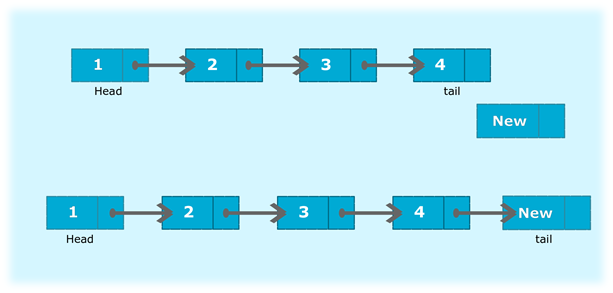Explanation
In this program, we will create a singly linked list and add a new node at the end of the list. To accomplish this task, add a new node after the tail of the list such that tail's next will point to the newly added node. Then, make this new node as the new tail of the list.

Consider the above list; node 4 represents the tail of the original list. Let node New is the new node which needs to be added at the end of the list. Make 4's next to point to New. Make New as the new tail of the list.
Algorithm
- Create a class Node which has two attributes: data and next. Next is a pointer to the next node in the list.
- Create another class InsertEnd which has two attributes: head and tail.
- addAtEnd() will add a new node at the end of the list:
- Create a new node.
- It first checks, whether the head is equal to null which means the list is empty.
- If the list is empty, both head and tail will point to a newly added node.
- If the list is not empty, the new node will be added to end of the list such that tail's next will point to a newly added node. This new node will become the new tail of the list.
- display() will display the nodes present in the list:
- Define a node current which will initially point to the head of the list.
- Traverse through the list till current points to null.
- Display each node by making current to point to node next to it in each iteration.
Input:
#Adding 1 to the list
sList.addAtEnd(1);
#Adding 2 to the list
sList.addAtEnd(2);
#Adding 3 to the list
sList.addAtEnd(3);
#Adding 4 to the list
sList.addAtEnd(4);
Output:
Adding nodes to the end of the list: 1
Adding nodes to the end of the list: 1 2
Adding nodes to the end of the list: 1 2 3
Adding nodes to the end of the list: 1 2 3 4
Python
Output:
C
Output:
JAVA
Output:
C#
Output:
PHP
Output: